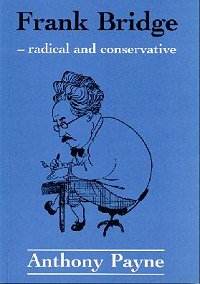Book Review
Frank Bridge – radical and conservative
By Anthony Payne
Thames Publishing. Paperback. 106 pages £12:50 ISBN 0 905210 25 5
AmazonUK AmazonUS
This is not a new book: it was published in 1999. Indeed it is an update of an earlier edition, published as The Music of Frank Bridge (1976), by Anthony Payne. Payne, is, of course, a music journalist (he has been music critic for both The Daily Telegraph and The Independent) and the composer who realised Elgar’s Third Symphony.Payne comments that in those days, "Many scores were unavailable, major works were still unpublished and only a handful of commercial recordings existed of his music. Compared with that of his English contemporaries, Bridge’s music was in a state of shameful neglect… The reasons for this sad state of affairs were not far to seek. Bridge’s increasingly modernistic tendencies during the 1920s and 1930s quickly lost him the sympathetic audience and critical responses his easier-going earlier style had won and by the time he died in 1941, his star had been eclipsed."
Since the 1970s, due in no small part to the efforts of the Frank Bridge Trust, more and more of his works have been recorded and with news from Chandos that they are about to embark on a major new Frank Bridge edition, this appreciation now has extra value.
The book is divided into eight sections: Frank Bridge: a prelude; the early chamber music; the first orchestral works; the middle period; years of transition; final harvest; and the final orchestral works.
Bridge was an experimenter; his style changed and evolved over the years "…he gave notice that he was not to be the kind of artist to settle in a style or emotional rut and endlessly cultivate the same territory." From the touching innocence of the romanticism of the early works, he turned gradually to material of increasing depth and individuality that showed influences of Berg and the Second Viennese School a far cry from British music in which a more acceptable modernism was tinged with Debussy, Ravel or Stravinsky. "Possibly the experience of the war marshalled the hidden forces in Bridge’s nature, and forced him to come to terms with them..."
Using many musical examples, Payne discusses all the works from the Cobbett Prize-winning Phantasie Piano Trio (1907), and probably his most popular orchestral work The Sea (1910-11), plus the ‘vigorous and inventive’ Danse Rhapsody (1908), through the works of his middle period like the sultry, languorous Summer, and his Second String Quartet, Bridge’s ‘first undoubted chamber masterpiece’, to the later works, praising Enter Spring and There is a Willow Grows Aslant a Brook (both 1927). Payne has a particular high regard for two of Bridge’s final orchestral works: the atmospheric twilight world of Phantasm for piano and orchestra (1931) and the funeral address over the lost of the 1914-18 war that is Oration.
This is an erudite appreciation of the music of a too long neglected and overshadowed British composer.
Ian Lace
